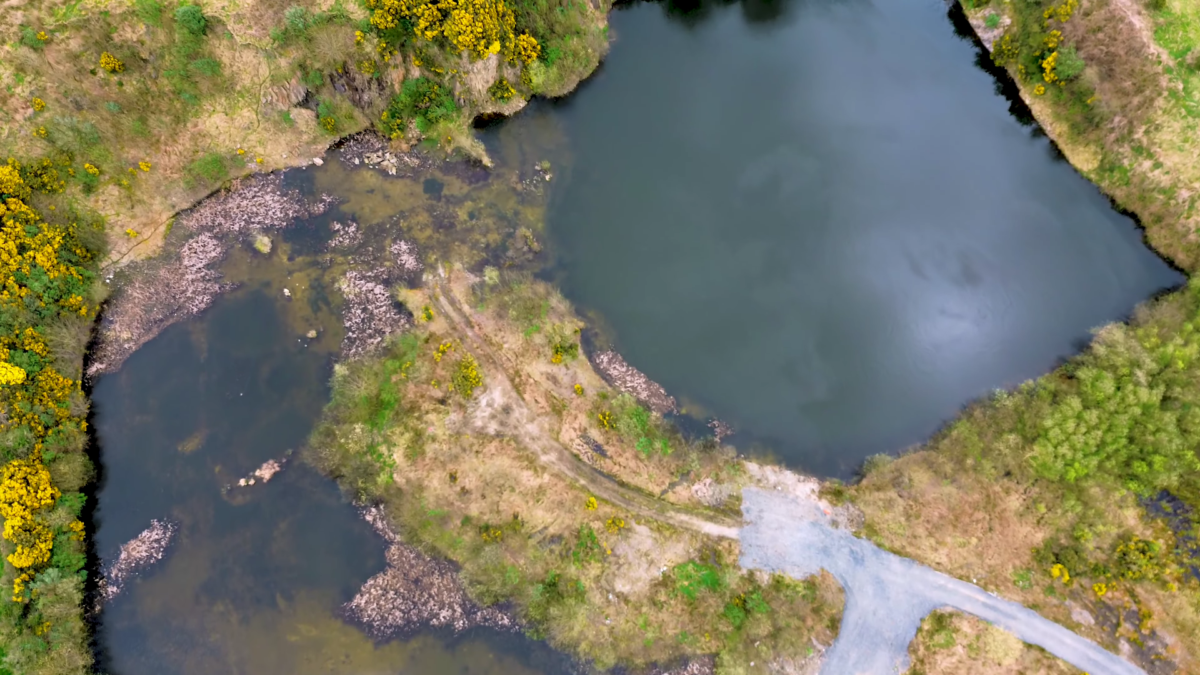
Illegal Dumping In Derry 💧 Podcast Ep. 48 Don’t Be A Waster
Illegal Dumping Derry: Podcast Ep. 48 | Don’t Be A Waster 💧
Listen on Apple Podcasts Listen on Spotify Listen on Google Podcasts Listen on Stitcher Listen on Amazon Music
Transcript: Illegal Dumping Derry
Illegal Dumping Derry 💧: Hello and welcome to another edition of your favourite podcast—well, hopefully, your favourite podcast—Recycle Don’t Be a Waster.
I’ve just come back from a trip overseas, back to my native land of Ireland, and when I was there, one of the biggest stories was, I suppose, all the bad things about the environment and recycling. That is: a monumental illegal dump. So, that’s a landfill that’s not properly licensed, that isn’t, you know, built or constructed correctly, and that basically is completely unmanaged and has significant environmental and other negative impacts.
To be honest, I’d never really considered what an illegal dump would do. Obviously, we’ve looked at the benefits of good quality landfills, etc., but this news story was on such a level that it really made me look into it a bit more from a health perspective, etc., and it’s—you know, it’s the sort of thing you often think occurs in, I suppose, countries a long way away, “of which we know very little,” to quote a former British Prime Minister.
But this one, I suppose, was much closer to home for me, and I realised that people are impacted from a health perspective. So, I thought I’d look a bit more into it.
Act 2: illegal dumping in Derry
The place in question is a place called Mobuoy Dump, which is outside the city of Derry—which is not a very big city. It’s roughly about 90,000 people, I believe, which is not much different to somewhere like a Ballarat or a Bendigo, and smaller than a Newcastle. So, not a mega city.
But apparently, there’s been an illegal dump outside the city for the last circa 10 years, where they’ve dumped up to 1.1—well, this is estimated, obviously, because they don’t actually know—but they assume it’s something along the lines of 1.1 million metric tons of illegal waste. And this is all types of waste. And obviously, because it’s illegal, there’s no restrictions on what’s going in there, so we have to assume: e-waste, asbestos, chemicals.
You know, I think if you think of the motivation for: why would people dump in this illegal dump?—it’s to avoid landfill fees, to avoid the cost of dumping there. So clearly, the cost will be—you know, that argument increases when the more toxic the waste is, the more likely you are to save significant funds by dumping in this waste.
Act 3: illegal dumping in Derry
I’m looking at a website—the BBC website—what used to be, or traditionally was, a respected journalistic site. So, hopefully we can take it on face value. And they said there’s been 1.16 million tons dumped in the river—or sorry, dumped in the landfill. And the landfill, which obviously has no proper lining or construction in place, is right next to a river called the River Faughan, which, incredibly, supplies a significant portion of the local city’s drinking water.
So, fundamentally what seems to be happening is the leachate, which is the bad stuff that drips out of this landfill down into the lower levels of the soil, basically flows with the water—as water flows—into the river, which then is, outrageously, being used for drinking water.
The sheer cost of what it will cost to rectify this scenario—like it’s literally, you’re talking made-up numbers. It’s monopoly money. I’ve read numbers between £7 million sterling up to £1.2 billion, so that’s roughly $2 billion Australian dollars to rectify this problem. Whether it does get rectified?
I’m looking at different stories here from local politicians, and people are saying it will not be a quick fix—basically saying, this is not going to be rectified. This is too big a problem, and the money isn’t there to fix it.
So, this made me, I suppose, think of two things. One was: what are the benefits or what are the characteristics of an actual landfill? And what is the danger of these illegal landfills?
Act 4: illegal dumping in Derry
You know, I’ve done a bit of research on this, and there’s quite a lot of severe negative impacts for the environment and also for human health. So, they’re saying if a landfill isn’t properly constructed—and that involves liners, leachate collection systems that are graded, the ground is graded in certain manners to collect the leachate, which is the water runoff, and also gas controls—it can be significantly dangerous.
So, I suppose we’ll go through them as we come to them.
The first one is the leachate. So basically, as the waste decomposes—and keep in mind that this is a non-regulated landfill—so there will be heavy metals, and they’re talking about mercury, lead, there’ll be solvents, there’ll be pesticides, there’ll be all this different stuff. And that will flow into the water table and into the river. And in this example, it’s even worse because the river literally flows next to it.
This will lead to what’s called eutrophication in water bodies, whereby the excess nutrients cause oxygen depletion, which creates a dead zone for fish and other wildlife. So, I suppose, even in the best-case scenario here, we’re looking at a dead river that’s not suitable for fish or any sort of life forms whatsoever.
Act 5: illegal dumping in Derry
Air pollution then is obviously a significant problem. Look—anyone who’s ever been near a landfill, and of course NIMBY (Not In My Backyard) generally reflects people not wanting facilities of this nature, you know, which are obviously required for cities to function—but nobody wants them right next to them.
And clearly, there’s the smell. Stuff breaks down, and it’s—it can smell pretty bad. So, you don’t want it nearby. You certainly don’t want it illegal, where it could be near to people’s homes.
One of the big things I probably didn’t realize is that in a landfill, stuff rots away. So, in theory, if an apple falls from a tree and rots, it releases carbon dioxide, because there’s oxygen—it’s in an oxygen-rich environment. If it falls—if it’s in a landfill where there is no oxygen, as the waste is packed together, it releases methane, which is significantly more greenhouse gas-causing, apparently, but also is significantly more flammable.
So, methane is flammable, posing explosion risk if it accumulates in enclosed spaces near the site.
This fundamentally means—and this is why, in engineered modern landfills—you have either flaring of gas, so gas capture that will either burn this methane to release it and, you know, get rid of that problem of explosion, or you will even have electricity generation, whereby through burning this methane, they create electricity. And it’s, in many ways, a very environmentally friendly and cost-effective method of electricity generation.
Act 6: illegal dumping in Derry
Obviously, in this scenario, none of that is happening with an illegal landfill. And unbelievably, you do have the risk then of explosions and fires.
These things also emit what are called volatile organic compounds—VOCs is the acronym, sorry—and other toxic gases like hydrogen sulfide, which smells like rotten eggs and can irritate eyes, nose, and lungs even at low levels.
So that’s, I suppose, the environmental aspect. And now we’re starting to touch on health impacts.
They talk about, I suppose, this part of it not being studied very well, but studies do show that there’s a higher level of asthma, eye irritation, nausea, and fatigue, even next to legal landfills. So, illegal—the evidence shows—it’s even higher.
Studies have linked proximity to such sites with increased risk of congenital anomalies, such as low birth weight, and even cancers, particularly in children, whose immune systems are more vulnerable.
The presence of hazardous waste—when we’re talking hazardous, we’re talking about the stuff that shouldn’t be going into landfills at all, even, you know, modern landfills—such as electronics containing lead or batteries leaking acids, which should be treated separately, further heightens these dangers, as the toxins can enter the body through inhalation, ingestion, or skin contact.
It then can interrupt biodiversity in ecosystems, and the spread of waste attracts pests like rats and crows, which can displace native species.
Look, it’s a pretty negative outcome, and it really makes clear why we need to—why these things are not just, I suppose, what they were 100 years ago, where you dig a hole in the ground and chuck stuff in.
Act 7: illegal dumping in Derry
Partly, you know, we do have probably more toxic materials now. We’re using a lot more batteries, we’re using a lot more chemicals, we’re using—we’ve been through the industrial revolution, the electronics revolution in recent years, and things are getting more—it is becoming a more and more serious problem.
So look, I think we’ll keep updated about this. It’s a pretty horrendous situation. It’s one that probably isn’t getting the media attention in Ireland or the United Kingdom that it probably deserves.
But it’s one where—you know there’s an old saying: you spend a pound or a dollar on maintenance, and you can save a lot of money down the line.
So, I think this is a scenario like that, whereby cutting costs—and people trying to—it also insinuates things such as corruption and bribery, whereby a lot of people over a long period of time were dumping this stuff illegally.
So, I think it’s one to look at. But it’s also one to really make us appreciate that proper waste management, proper recycling—first of all, not dumping this stuff in landfills—it really carries a lot of environmental problems.
Act 8: illegal dumping in Derry
And I think we all talk about, you know, climate change, etc., greenhouse gases, and that’s often where, certainly, political focus is. But, you know, this is serious stuff. You do not want illegal dumping of, you know, electronic waste, of toxic waste—like, it’s almost like stating the obvious that we don’t want toxic waste dumped illegally—but it really highlights why proper treatment of these things is so important.
One of the reasons why in Australia, they’re really increasing the regulations on disposal of substances such as asbestos and e-waste, etc., which should not be going into general waste or garbage trucks at all anymore.
So look, we’ll leave it there today. I think this is, I suppose, a lesson for us—one to take on board, and one to—sometimes, you need to appreciate where money is spent, and needs to be spent, on proper engineering, you know, these facilities, to make sure we don’t have to have these discussions.
Alright—Recycle. Don’t be a Waster.
Leave a Reply Cancel reply


